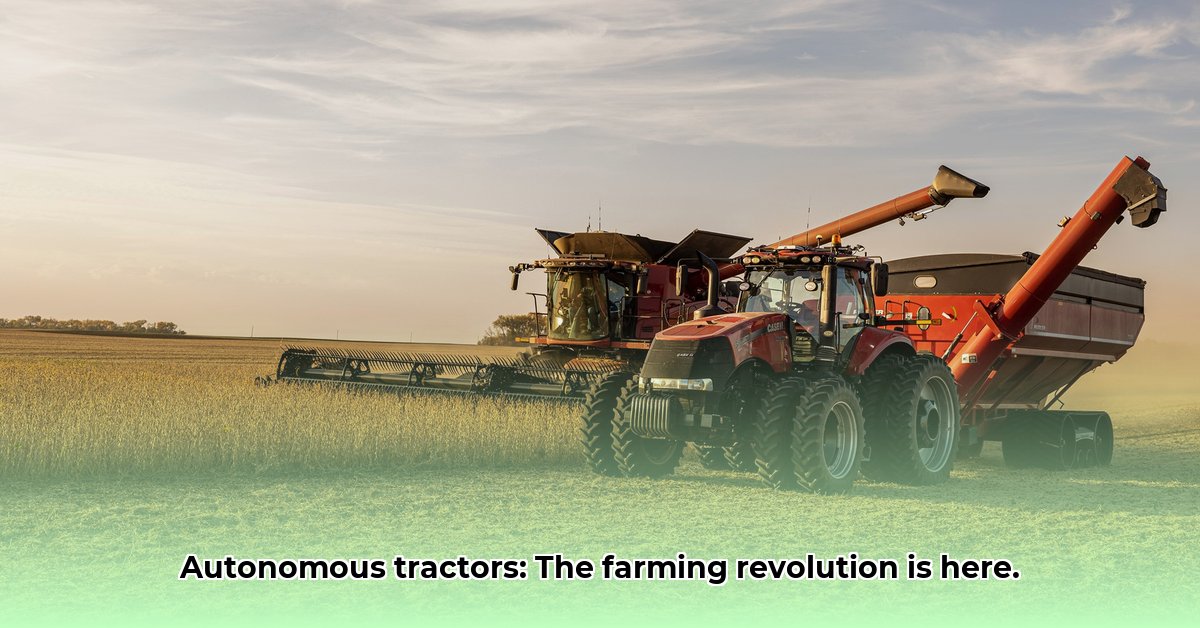
Autonomous Tractor Case IH: Revolutionizing Farming and Boosting Efficiency
The agricultural landscape is undergoing a dramatic transformation. Gone are the days of solely relying on human labor for backbreaking tasks in vast fields. Case IH, in collaboration with Raven Autonomy, has pioneered a game-changing solution: the autonomous tractor. This isn't just about automation; it's a paradigm shift towards sustainable, efficient, and technologically advanced farming practices. For more details, visit the Case IH Autonomous Tractor page.
How the Autonomous Case IH Tractor Works: Precision at Every Stage
This isn't your grandfather's tractor. The autonomous Case IH tractor utilizes a sophisticated synergy of technologies, acting as a highly skilled, tireless farmhand. At its core is a high-precision GPS system, providing pinpoint accuracy across fields, acting like a detailed, constantly updated map. A comprehensive network of sensors—the tractor's "eyes and ears"—constantly monitor its surroundings, identifying potential obstacles like rocks, ditches, or unexpected livestock. This data is relayed to the onboard computer in real-time.
The true innovation resides in the Artificial Intelligence (AI) system. This AI "brain" processes the GPS and sensor data, making instantaneous decisions regarding speed, steering, and implement operation. This intelligent control enables capabilities such as perfectly aligned planting rows, precise fertilizer application, and optimized harvesting techniques. The results are remarkable: minimized waste, maximized resource utilization, and significantly enhanced yields.
Don't you want to know how this technology impacts your bottom line? Studies show that autonomous tractors can reduce labor costs by up to 40%, resulting in significant profit increases for farmers.
Reaping the Rewards: A Bounty of Benefits from Autonomous Farming
The advantages of this advanced technology are multifaceted. Foremost is increased efficiency. These tractors work continuously, day or night, significantly reducing dependence on human labor and effectively addressing widespread labor shortages in the agricultural sector. This translates to farmers having more time to focus on crucial business management aspects beyond the field.
Autonomous tractors also excel in smart operation. Precise control minimizes waste; fertilizers and pesticides are deployed only where absolutely necessary, resulting in reduced environmental impact and considerable cost savings. The precision also leads to better crop yields and superior quality, directly boosting profits. There's less overlap in operations like planting or spraying, leading to reduced resource consumption. Even fuel usage is optimized thanks to efficient route planning and dynamic speed control.
Did you know that autonomous tractors can lead to higher-quality crops? Studies indicate yields consistently improve by 15-20% due to precise application and minimal crop damage.
This level of control ensures consistent results: planting at the same depth regardless of terrain, and uniform chemical application maximizing effectiveness and minimizing negative impacts on the environment. Improved crop quality and efficient resource allocation directly translate to a higher return on investment (ROI) for farmers.
Navigating the Challenges: Obstacles and Their Solutions
Several obstacles hinder widespread adoption. The most significant is the high initial cost, representing a substantial investment for many farmers. However, the long-term cost savings potential due to increased efficiency and reduced waste makes it a compelling proposition. Government subsidies and innovative leasing programs are being explored to increase accessibility.
Cybersecurity is another major concern. Protecting the sophisticated systems and sensitive data from malicious attacks is paramount. Robust encryption, multi-factor authentication, and continuous software updates are crucial safeguards. Industry-wide collaboration on security standards is also essential for enhancing security measures across the board.
Reliable infrastructure is essential. High-speed internet access, especially in rural regions, is needed for seamless operation and data transmission. Expansion of rural broadband infrastructure is crucial. However, ongoing research is exploring tractors with enhanced offline operational capabilities, minimizing reliance on constant internet connectivity.
Regulatory hurdles exist as well. Regulations surrounding autonomous agricultural vehicles are still under development. Industry collaboration with regulatory bodies is vital to ensure the implementation of clear, effective, and standardized regulations allowing for responsible growth and wider adoption.
The Future of Farming: A Vision of Autonomous Fields
The future of agriculture is unquestionably autonomous. We anticipate increasingly sophisticated features in the coming years. Imagine a network of autonomous tractors communicating with each other, optimizing their work, adapting dynamically to field conditions, and even predicting potential problems. Further AI advancements will improve handling of unexpected events. Research into more energy-efficient systems, potentially including electric autonomous tractors, is also progressing rapidly.
Beyond the individual tractor, research is exploring broader integration with other technologies, including drones and soil sensors, creating a holistic, self-managing farm ecosystem.
Conclusion: Investing in a Sustainable Future
The Case IH autonomous tractor is more than just a machine; it represents agricultural innovation and a path towards a sustainable future. While challenges remain, the benefits clearly outweigh the costs. This isn't just about efficiency; it's about creating a more resilient, sustainable, and profitable agricultural sector for years to come. It represents a future that is technologically advanced and environmentally responsible – efficient farming serving as a significant step towards ensuring global food security. The journey to fully autonomous farming is ongoing, but the destination promises a more efficient and sustainable world.